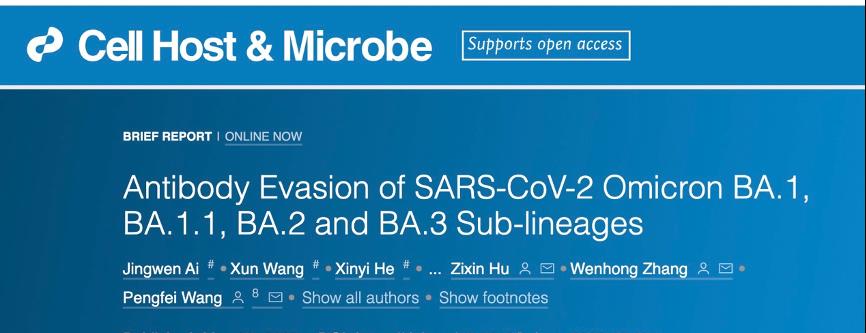On May 10, the "Huashan Infection" WeChat public account published an article titled "Cell Host & Microbe Research Release: Responding to Multiple Variants of Aumicron and Strengthening the Need for Vaccination".
According to the article, the team of Zhang Wenhong, director of the National Center for Infectious Disease Medicine and director of the Department of Infectious Diseases of Huashan Hospital Affiliated to Fudan University, and Wang Pengfei's team from the School of Life Sciences of Fudan University recently worked together to evaluate the immune escape characteristics of four subtypes of the Semiquerong variant after two doses of inactivated vaccine and the third dose of enhanced vaccination. The study further confirms that in response to Omi kerong, vaccination of booster needles is still an effective means.
The study found that the antibody titer levels of the Two-Shot Inactivated Vaccine subjects to the Semickon strain decreased by at least 5.3 times compared to the original strain. After the third dose of homologous (inactivated vaccine) or heterologous inoculation, the antibody titer is significantly elevated, and the antibody positivity rate reaches at least 75%.
The study further confirms that vaccination of booster needles remains one of the most effective means of dealing with Omi kerong. Although the case fatality and severe disease rate of the original strain and Delta strain have decreased, it can still lead to an increase in the severe disease rate of the elderly or immunodeficient population, so it is important to further increase the proportion of full vaccination and strengthen the vaccination rate for the population suitable for vaccination.
The full text is as follows:
Recently, the National Center for Infectious Disease Medicine, the Shanghai Key Laboratory of Infectious Diseases and Biosafety Emergency Response, the team of Professor Zhang Wenhong of Huashan Infection, and the team of Professor Wang Pengfei of the School of Life Sciences of Fudan University jointly evaluated the immune escape characteristics of four subtypes of the Aomi Kerong variant after two doses of inactivated vaccine and the third dose of enhanced vaccination, and the results were published in the journal Cell Host and Microbe on May 8 (2021 IF 21.023).
As of May 2022, more than 510 million cases of COVID-100 have been reported worldwide. The Omiljung variant of SARS-CoV-2 was first detected in November 2020, and has been widely circulated around the world, with multiple sub-lineages, named BA.1, BA.1.1, BA.2, BA.3, BA.4, BA.5, etc., and recombinant subtype XD, XE, XF strains have also been recently detected. In the past 1-2 months, the proportion of BA.2 subtypes has risen rapidly, becoming the main epidemic strain in many recent outbreaks. Epidemiological studies have shown that BA.2 has been detected in more than 40 countries and regions, its transmission capacity is about 30% higher than BA.1, and the viral load after infection is 2 times higher than that of BA.1; its subtype BA.2.12.1 contains L452Q mutations, which is more detected in the United States and has a transmission advantage.
Sensitivity of each of the Omikeron subtypes to the neutralization capacity of existing vaccine-induced or monoclonal antibodies

The study found that the antibody titer levels of the Two-Shot Inactivated Vaccine subjects to the Semickon strain were at least 5.3 times lower than those of the original strain. Experimental evaluations of four subtypes of pseudoviruses showed that the neutralizing antibody titers against BA.2 were similar to or lower than BA.1. After the third dose of homologous (inactivated vaccine) or heterologous inoculation, the antibody titer is significantly elevated, and the antibody positivity rate reaches at least 75%. Recently, three recombinant lineages (XD, XE, and XF) have been reported, but their antibody escape is not expected to differ significantly from the 4 Semiconian sublineages studied because their S proteins are identical to BA.1 or BA.2.
The neutralization ability of the Aomi Kerong BA.1 strain has been explored in the past
In fact, in December 2021, The team of Professor Zhang Wenhong and Professor Wang Pengfei of Huashan Infection assessed the neutralization ability of the Aomi Kerong BA.1 strain in the serum samples of two inactivated vaccines and three injections of homologous/heterologous inoculation, and the study found that the antibody titer of the two-shot inactivated vaccine against the Aomi Kerong variant strain decreased significantly, and the neutralizing antibody titer dropped to 6.04, which was about 10 times lower than that of the original strain. Regardless of the type of third injection boosted (inactivated vaccine or recombinant subunit protein seedling), the positive rate of neutralizing antibody titers of serum specimens to the Omikejung strain reached 100%.
The scientific significance of this study
The study further confirms that for people who are suitable for vaccination, the promotion of vaccine-boosted injections is still one of the effective means to prevent the spread of SARS-CoV-2, especially the transmission of the Omiljung strain. Although the case fatality and severe disease rate of the original strain and Delta strain have decreased, it can still lead to an increase in the severe disease rate of the elderly or immunodeficient population, so it is important to further increase the proportion of full vaccination and strengthen the vaccination rate for the population suitable for vaccination.